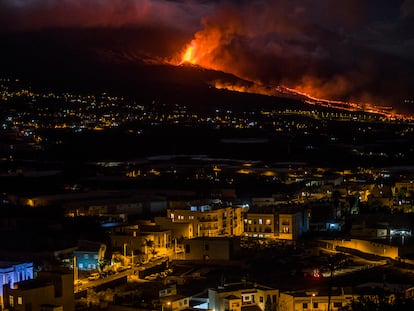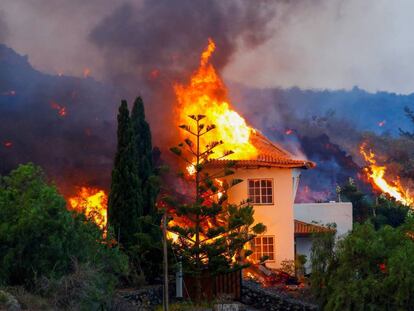From ash to acid rain: Seven dangers of the volcanic eruption in La Palma
Spain’s National Geographic Institute outlines several risks including toxic gases and lava flows, which have already swallowed up houses, infrastructure and crops on the Canary Island
Juan Acosta Rodríguez, a resident of Las Indias in La Palma, in Spain’s Canary Islands, was the only official victim of the eruption at Teneguía on October 26, 1971 – the last one on record on the island until last Sunday, when a new eruption took place in the area. He died from inhaling toxic gases in the area of Los Percheles. It is suspected that this was also linked to the cause of death of photographer Heriberto Felipe Hernández, from Santa Cruz de La Palma, who died in hospital with poisoning symptoms after going to the affected area on several excursions. Both were victims of one of the main dangers identified by Spain’s National Geographic Institute (IGN) following a volcanic eruption: lava flows, ash, pyroclastic flow, gas emission, lahars, landslides and tsunamis.
1. Lava flows. This is the magma that has reached the surface during a volcanic eruption and flows effusively away from the vent. The more viscous it is, the less distance the flow will travel, but the thicker it will be. If it is more fluid, the lava flow, being less thick, can cover great expanses. Speaking about the eruption in La Palma, Mariano Hernández Zapata, the president of the island council, explained: “A lava flow measuring six meters tall is literally eating up the houses, infrastructure and crops that it is finding on its path toward the coast in the valley of Aridane.” So far, more than a hundred homes have been swallowed up by the lava flows in the wake of the eruption in La Palma, which began on Sunday. Scientists studying the situation estimate that the lava flow will enter the sea from the coast of Tazacorte, possibly from Playa Nuevo beach in Los Guirres.
2. Ash. The Canary Islands Volcano Emergency Plan (Pevolca) has warned that ash being spewed out from the volcano in the Cabeza de Vaca area of Cumbre Vieja national park could cause “injuries to respiratory airways, eyes and open injuries as well as skin irritation.” For this reason, Pevolca recommends against exposure to ash. According to the IGN, “during an explosive eruption, a mix of gases and pyroclasts [solid fragments of volcanic material] is released into the atmosphere.” “Molten bombs” are larger fragments that are ejected like bullets from the center of emission, but have less reach, of just a few kilometers. The rest of the particles are lifted up by volcanic gases and create a cloud, which can become a convective plume stretching tens of kilometers. When the density of gases and particles is the same as the surrounding atmosphere, it begins to “rain” ash, which is dispersed by the wind and turbulence, and can cover enormous areas, spanning up to thousands of square meters and reaching meters in depth. With respect to the volcano on La Palma, “if a more intense explosive phase is generated, the ash could reach a larger area and affect, for example, the airport. But we have to wait to see its progress,” explains Joan Martí, a volcanologist and head of the Geosciences Barcelona group at Spain’s national research center CSIC.
3. Pyroclastic flow. If the plume created by an explosive eruption does not have enough energy or is less dense than the surrounding atmosphere, a collapse happens, creating dense flows that mix high-temperature gases and solid particles (up to 700ºC), and travel at very high speeds (up to 550 kilometers per hour). When these flows are more diluted, their movement is more turbulent and they are called pyroclastic waves. Both types are called pyroclastic flows.
4. Gas emanation. The volcano in La Palma has emitted between 6,000 and 9,000 tons of sulfur dioxide (SO₂) a day, according to the preliminary calculations from the Canary Volcanology Institute (Involcan). The gases that are initially dissolved in magma separate from the magma during the eruption and are released into the atmosphere at high temperatures and speeds. As well as being violently ejected, the gases can also escape from small fissures or vents in the volcano’s edifice and in the surrounding area. This happens more or less continuously, creating what is known as fumaroles. Some gases, such as carbon dioxide, can escape by diffusion through the earth in large areas around the volcano edifice and create a cloud that moves just a few centimeters above the ground, depending on the topography, until it is dispersed in the atmosphere.
Gases ejected into the atmosphere can cause acid rain when they meet with condensation or the beginning of rainfall. The gases can trigger headaches, vomiting, choking and skin and eye irritation, as well as damage crops and metal structures. These emissions, which can reach hundreds of kilometers, can also cause air and water pollution. The Portuguese Sea and Atmosphere Institute (IPMA), believes that ash, carbon dioxide and sulfur dioxide from the volcano in La Palma could reach the Portuguese island of Madeira, “although the forecast impact for this region does not correspond to a critical situation,” they say.
5. Lahars or mudflow. The IGN also lists lahars as a danger following an eruption. This is a flow of volcanic material, particularly ash, that is mobilized by rain, the melting of ice and snow and the collapse of land. It behaves similarly to a flood, it is channeled down ravines, taking with it all in its path, which increases its destructive power. Lahars can happen during an eruption, or months afterwards following torrential rain, according to the IGN, meaning the danger will persist long after the eruption in La Palma has ceased.
6. Landslides. The fall of hard and soft material from the volcano edifice can create an unstable structure, leading part of the edifice to collapse. Water or the entry of large volumes of molten rock could cause a landslide.
7. Tsunamis. A tsunami, a giant surge of water, could be triggered by a landslide in the volcano edifice, mass pyroclastic flows or an underwater eruption. These waves can reach meters in height and grow to dozens or even hundreds of meters from the shore.
English version by Melissa Kitson.
Tu suscripción se está usando en otro dispositivo
¿Quieres añadir otro usuario a tu suscripción?
Si continúas leyendo en este dispositivo, no se podrá leer en el otro.
FlechaTu suscripción se está usando en otro dispositivo y solo puedes acceder a EL PAÍS desde un dispositivo a la vez.
Si quieres compartir tu cuenta, cambia tu suscripción a la modalidad Premium, así podrás añadir otro usuario. Cada uno accederá con su propia cuenta de email, lo que os permitirá personalizar vuestra experiencia en EL PAÍS.
¿Tienes una suscripción de empresa? Accede aquí para contratar más cuentas.
En el caso de no saber quién está usando tu cuenta, te recomendamos cambiar tu contraseña aquí.
Si decides continuar compartiendo tu cuenta, este mensaje se mostrará en tu dispositivo y en el de la otra persona que está usando tu cuenta de forma indefinida, afectando a tu experiencia de lectura. Puedes consultar aquí los términos y condiciones de la suscripción digital.
More information

Lava from La Palma volcano comes close to the sea, raising risk of toxic gases
Últimas noticias
Most viewed
- Sinaloa Cartel war is taking its toll on Los Chapitos
- Oona Chaplin: ‘I told James Cameron that I was living in a treehouse and starting a permaculture project with a friend’
- Reinhard Genzel, Nobel laureate in physics: ‘One-minute videos will never give you the truth’
- Why the price of coffee has skyrocketed: from Brazilian plantations to specialty coffee houses
- Silver prices are going crazy: This is what’s fueling the rally











































